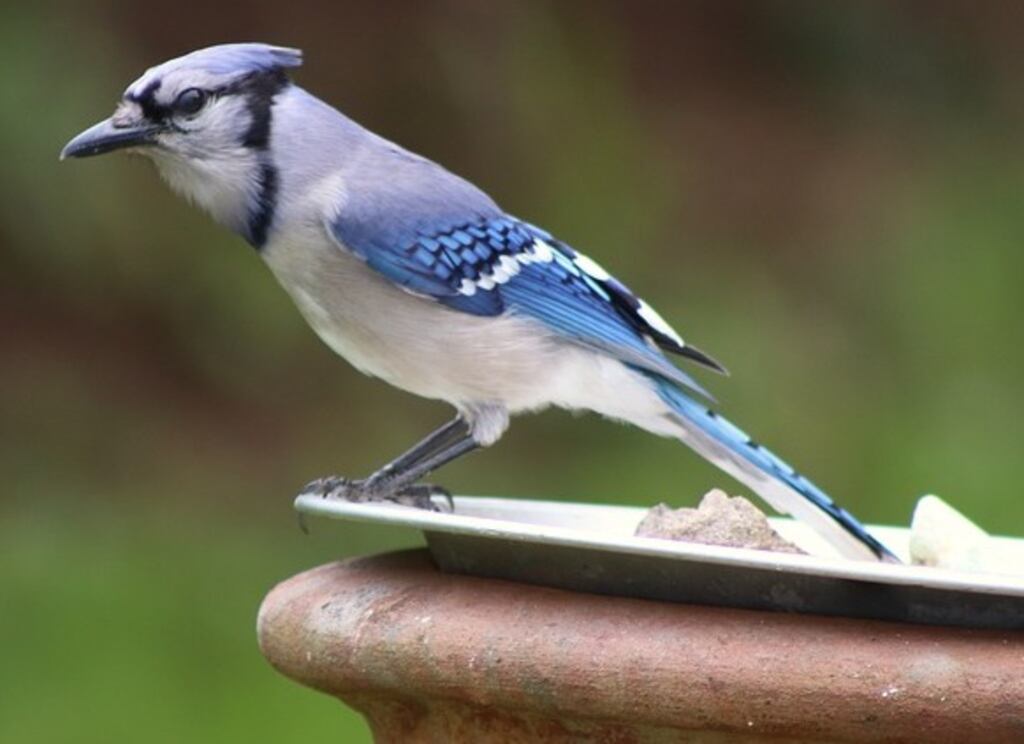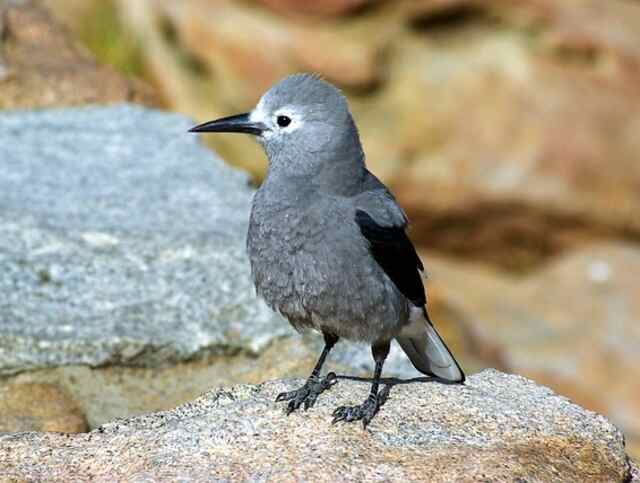Get ready to soar with the Blue Jays and their doppelgangers! These charismatic birds are a favorite among birdwatchers and nature enthusiasts, known for their striking blue plumage and distinctive calls. But did you know that there are other avian species that resemble these feathered friends?
Hold on to your binoculars as we introduce you to the top 13 birds that look like Blue Jays in every way imaginable! From the vibrant Indigo Bunting to the majestic Stellar’s Jay, these winged wonders will have you seeing blue in a whole new light.
Join us as we explore the unique features, behavior, and habitats of each of these Blue Jay lookalikes and uncover the secrets of their uncanny resemblance.
Blue Jay (Overview)
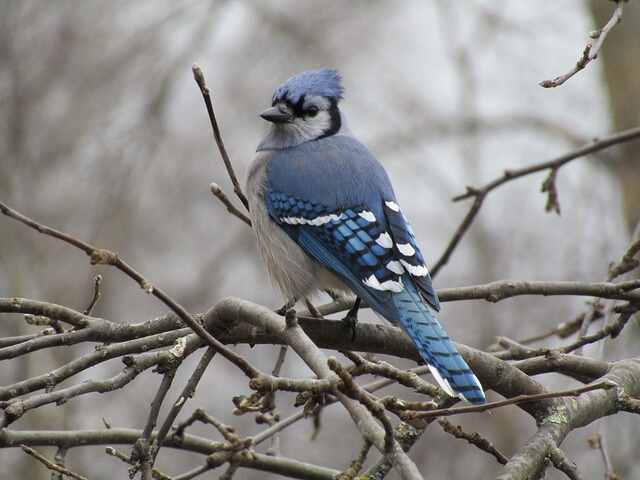
Blue jays are common birds found throughout eastern and central North America. Their habitat includes forests, woodlands, parks, and residential areas. These birds are omnivorous and feed on insects, nuts, seeds, and fruits.
They are also known to raid other bird’s nests for eggs and young. Blue jays are known for their striking blue plumage with black and white markings, and their distinctive crest.
They are also known for their loud calls and aggressive behavior, often dominating bird feeders and chasing away other birds. Blue jays are intelligent birds that can mimic other bird’s calls and even some human sounds.
Birds That Look Like Blue Jays
Indigo Bunting
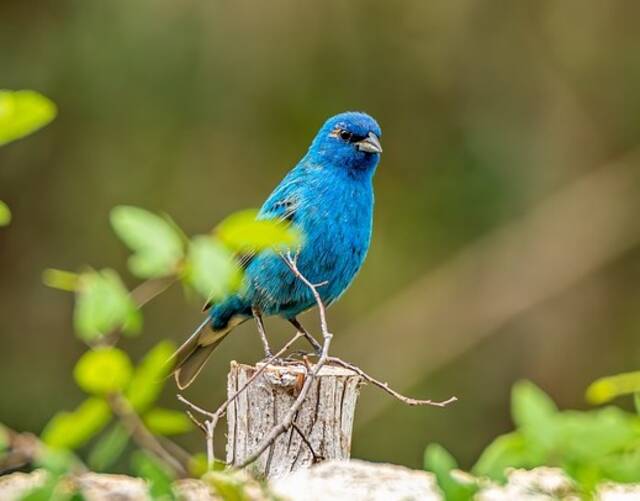
The Indigo Bunting is a small bird with a body length of about 12.5 cm and a wingspan of around 20 cm. Unlike Blue Jays, Indigo Buntings lack the white markings on their wings and tail feathers. The male birds have a vibrant blue plumage, while females are a duller brown color with blue highlights.
Indigo Buntings are found throughout the eastern United States and parts of Canada, with a preference for open woodland and edges. Their diet consists of insects, seeds, and berries, and they are known for their distinctive song, which is often heard during the summer months.
Despite their differences in size and plumage, Blue Jays and Indigo Buntings share some similarities in their habits and behaviors. Both species are known to be omnivorous and enjoy a diet of seeds and berries.
They are also known for their strong, distinctive calls and songs, which can be heard echoing through the woods. However, Blue Jays are generally larger and more social birds, while Indigo Buntings tend to be more elusive and solitary.
Read more: How to Attract Indigo Bunting to your Yard? Expert Tips!
Mountain Bluebird

The Mountain Bluebird (Sialia currucoides) is a medium-sized thrush that is found throughout the western half of North America, from Alaska to Mexico. These birds are easily identifiable by their stunning blue plumage, white underbelly, and thin bill.
They typically inhabit open areas such as meadows, prairies, and mountain valleys, and can often be seen perched on fence posts or tree branches. The Mountain Bluebird’s diet consists mainly of insects, with occasional seeds and fruits added in.
In comparison to the Blue Jay, the Mountain Bluebird is smaller in size and has a more slender bill. Their blue coloration is also lighter and more muted than the bold and vibrant blue of the Blue Jay.
While both birds share similar habitats, the Mountain Bluebird tends to prefer more open areas and is less likely to visit backyard feeders. In terms of behavior, the Mountain Bluebird is known for its graceful and acrobatic flight patterns, while the
Blue Jay is more assertive and vocal. Nonetheless, both birds are admired for their beauty and play important roles in their respective ecosystems.
California Scrub-Jay

The California Scrub Jay, also known as the Western Scrub Jay, is a small bird that typically measures around 11 inches in length. They are found in western North America, from southern Oregon to Baja California, Mexico. These jays prefer scrublands, oak savannas, and open woodlands as their habitat.
Their diet mainly consists of insects, seeds, and fruits, but they are also known to feed on small vertebrates and eggs. In terms of appearance, the California Scrub Jay shares some similarities with the Blue Jay, including their striking blue coloration and distinctive crests.
However, they are slightly smaller in size and lack the prominent white markings found on the Blue Jay’s wings and tail. Additionally, California Scrub Jays are known for their bold and inquisitive personalities, often approaching humans in search of food.
Overall, while there are some similarities between these two jay species, there are also clear differences that set them apart in terms of size, color, and behavior.
Florida Scrub-Jay
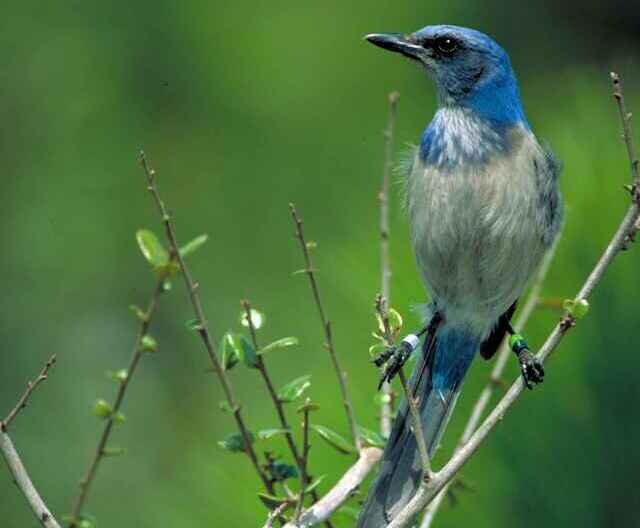
The Florida Scrub-Jay, known for its striking blue feathers and prominent crest, is a non-migratory bird endemic to the state of Florida. Their preferred habitat is the sand pine scrub, a unique and threatened ecosystem found only in the southeastern United States.
They primarily feed on insects, seeds, and fruits, and are known to cache food for later consumption. Unfortunately, habitat loss and fragmentation have resulted in a decline in their population, making them a species of concern for conservation efforts.
While the Florida Scrub-Jay shares many similarities with the Blue Jay, including their vibrant blue coloration and distinctive crest, there are also several differences between the two species.
The Florida Scrub-Jay is smaller and lacks the black markings and white wing bars of the Blue Jay. They also have different habits and behaviors, with the Florida Scrub-Jay being a year-round resident and the Blue Jay being a migratory bird.
Despite these differences, both species share a love for acorns and are known to cache food for later consumption.
Steller’s Jay

The Steller’s Jay (Cyanocitta stelleri) is a striking bird native to western North America. Known for its vibrant blue plumage, black crest, and white eyebrows, it can be found in a range of habitats, including coniferous forests, woodlands, and suburban areas.
These jays are opportunistic feeders, with a varied diet that includes insects, nuts, berries, and seeds. They are also known for their raucous calls and playful behavior, often gathering in large groups to forage or roost.
Their range extends from Alaska to California, and they can be found as far east as Montana. While the Steller’s Jay and the Blue Jay share some similarities, they also have distinct differences.
Steller’s Jays are slightly smaller than Blue Jays, with a shorter tail and crest. They also have a darker blue coloring with black heads and white eyebrows, while Blue Jays have a lighter blue color with a distinct crest and black markings on their neck and head.
In terms of behavior, Stellar’s Jays are known for being more social and less aggressive than Blue Jays, and they are also more likely to forage on the ground.
Read more: How to Attract Steller’s Jay to your Yard – Expert Tips!
Canada Jay
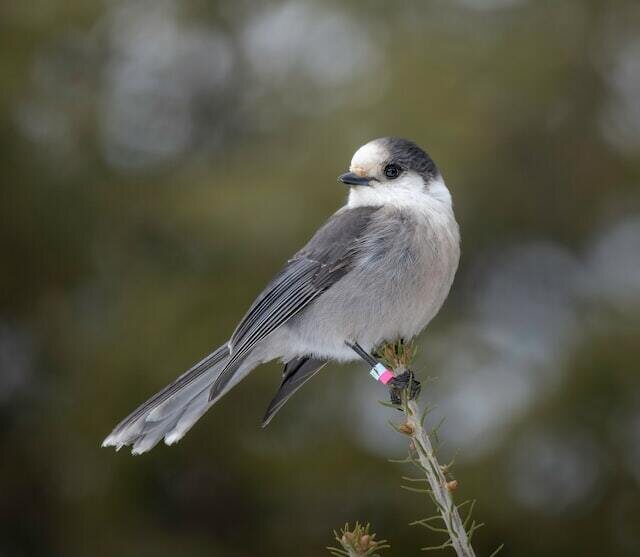
The Canada Jay, also known as the Gray Jay, is a hardy bird found throughout the boreal forests of North America. With its gray body, black cap, and white forehead, this jay is easily identifiable. The Canada Jay is also known for its friendly demeanor, often approaching people for food.
They are omnivorous, feeding on insects, berries, and carrion. These birds are also known to cache food during the winter months, creating hidden food stores for later use. The Canada Jay is a year-round resident of its range, which stretches from Alaska to the eastern seaboard of the United States.
While the Canada Jay and the Blue Jay share a similar name and a love of acorns, they differ in many ways. The Canada Jay is smaller in size and has a more muted color palette compared to the Blue Jay’s vibrant blue and white markings. The Canada Jay is also known for its tameness, while the Blue Jay can be more aggressive and vocal.
Additionally, the Canada Jay is a year-round resident of the boreal forests, while the Blue Jay is a migratory bird that is only present in certain regions during specific times of the year.
Woodhouse’s Scrub Jay
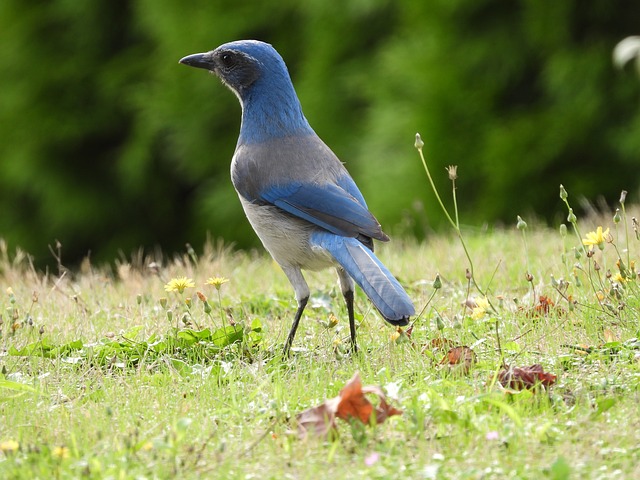
The Woodhouse’s Scrub Jay (Aphelocoma woodhouseii) is a medium-sized bird found in western North America. It is characterized by its blue-gray head, back, and wings, with a white belly and a long tail. Its habitat includes desert scrublands and pine-oak woodlands, and it is known for being a vocal and active bird.
Its diet consists mainly of insects, acorns, and seeds. The Woodhouse’s Scrub Jay is known to cache food items in the ground for future consumption. Compared to the Blue Jay, the Woodhouse’s Scrub Jay is smaller in size, with a more muted blue coloration.
While Blue Jays are found in eastern North America, the Woodhouse’s Scrub Jay inhabits the western regions. Both species are known for their intelligence, adaptability, and social behavior, although the Woodhouse’s Scrub Jay is more closely associated with arid and semi-arid habitats.
Additionally, while Blue Jays are known for their loud calls and mimicry skills, the Woodhouse’s Scrub Jay has a more melodious and varied vocalization.
Mexican Jay

The Mexican Jay, also known as the Gray-breasted Jay, is a medium-sized bird that is found in the southwestern United States and Mexico. These social birds live in large groups and have a distinctive blue-gray color with a black head and white throat. They inhabit a variety of habitats including pine and oak woodlands, canyons, and desert scrub.
Their diet consists mainly of insects, seeds, and fruits, but they also eat small vertebrates such as lizards and snakes. In terms of similarities to the Blue Jay, both birds have striking blue plumage and are known for their raucous calls. However, the Mexican Jay is smaller than the Blue Jay and has a gray breast instead of the white found on the Blue Jay.
The Mexican Jay is also less aggressive and more social than the Blue Jay, often living in large family groups and working together to find food and defend their territory.
While both birds have similar diets, the Mexican Jay is more likely to eat insects and small vertebrates, while the Blue Jay primarily feeds on nuts and seeds.
Pinyon Jay
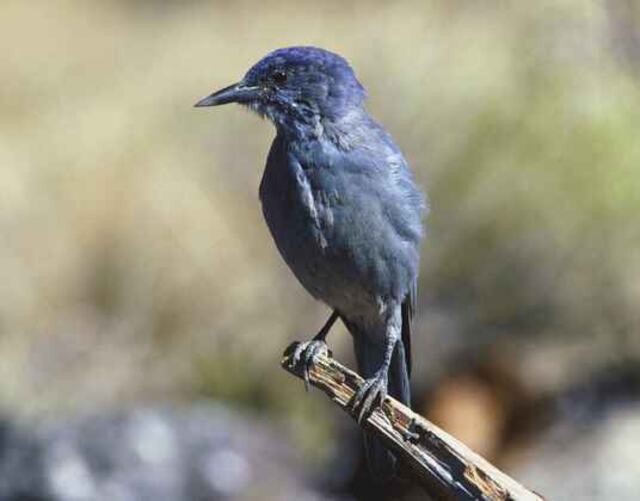
The Pinyon Jay (Gymnorhinus cyanocephalus) is a social and gregarious bird species found in the western United States. They have a distinct blue-gray coloration, with a dark cap, and a pale belly. Pinyon Jays are known for their loud and raucous calls and their communal nesting habits.
They primarily feed on pine seeds, but also consume insects, fruits, and berries. These birds are often found in pinyon-juniper woodlands and pine forests at elevations ranging from 3,500 to 9,500 feet. Compared to the Blue Jay, the Pinyon Jay is smaller in size and lacks the white markings on its wings and tail.
While both species are known for their raucous calls, the Pinyon Jay has a higher-pitched and more nasal call. Additionally, Pinyon Jays are known for their communal nesting habits and the Blue Jay is a solitary nester.
Overall, while the Pinyon Jay and the Blue Jay share some similarities in appearance and behavior, they also have many distinct differences that make them unique species in their own right.
Green Jay
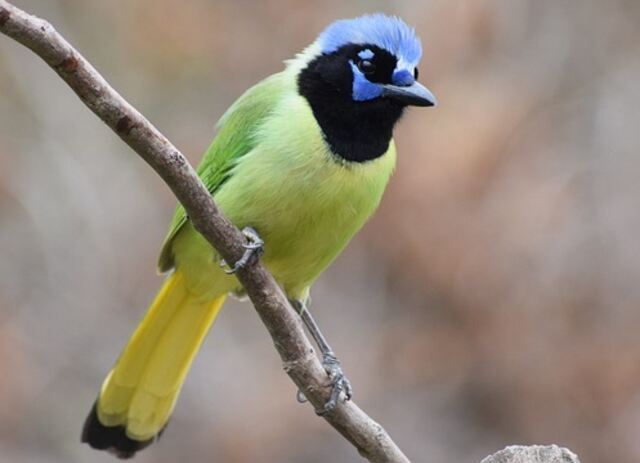
The Green Jay (Cyanocorax yncas) is a colorful passerine bird found primarily in Central America, from southern Mexico to Honduras. These omnivorous birds are known for their striking green, blue, and yellow plumage, with black markings on their face and chest. They prefer to live in dense forests, particularly in lowland regions, but can also be found in scrubland and urban environments.
Their diet consists of insects, fruits, and seeds, and they are known to store food in caches for later use. In terms of similarities and differences to the Blue Jay, the Green Jay is slightly smaller in size, measuring around 11 inches in length compared to the Blue Jay’s 12 inches.
While both species have blue and black markings on their feathers, the Green Jay’s green and yellow coloration sets it apart from its blue and white cousin. Additionally, Green Jays are known for their raucous and gregarious behavior, often living in large flocks and engaging in playful antics.
Despite their differences, both the Blue Jay and Green Jay are beloved members of the corvid family and continue to captivate birdwatchers around the world.
Clark’s Nutcracker
Clark’s Nutcracker (Nucifraga columbiana) is a passerine bird species found in western North America. These birds are named after William Clark, who first documented the species in 1805 along the banks of the Salmon River on the Lewis and Clark Expedition.
They are medium-sized birds, measuring around 11.5 inches in length, with grayish-brown feathers, black wings, and a distinctive white patch on their wings. Clark’s Nutcrackers are known for their ability to store food for the winter months, often burying seeds and nuts in the ground to retrieve later.
They live in subalpine forests and can be found throughout the Rocky Mountains. Compared to Blue Jays, Clark’s Nutcrackers have a smaller and more compact body, measuring around 11.5 inches in length compared to the Blue Jay’s 12 inches. They have a distinct grayish-brown coloration, with black wings and a white patch on their wings.
Unlike Blue Jays, Clark’s Nutcrackers are not known for their vocalizations, and instead communicate through body language and visual cues. However, like Blue Jays, they are known for their ability to store food for the winter months, and their habit of caching seeds and nuts can have a positive impact on the forests where they live.
White-throated Magpie-Jay
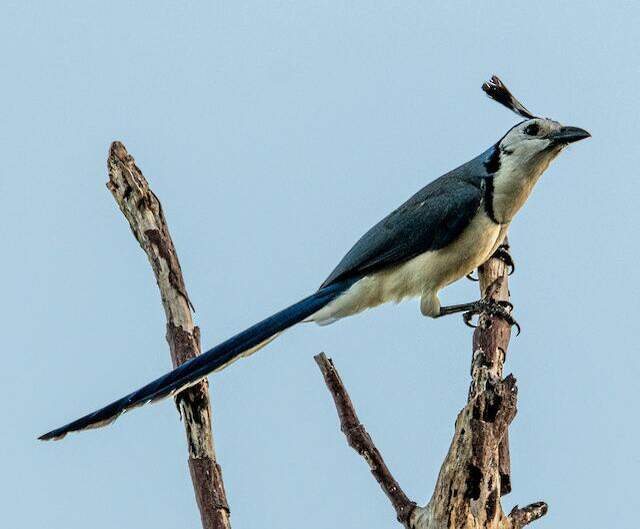
The White-throated Magpie-Jay (Calocitta formosa) is a strikingly beautiful bird found primarily in the Pacific coastal regions of Mexico and Central America. They have striking blue, black, and white plumage, with a distinctive white patch on their throat.
They prefer to live in open woodlands, savannas, and forest edges, where they can forage for a variety of food, including fruits, insects, and small vertebrates. They are known for their raucous calls and gregarious behavior, often living in large family groups.
Compared to the Blue Jay, the White-throated Magpie-Jay is larger in size, measuring up to 22 inches in length compared to the Blue Jay’s 12 inches. Their coloration is also distinct, with a blue and white body and black markings on their head and wings.
In terms of behavior, both species are known for their loud and vocal calls, but the White-throated Magpie-Jay is often more social and can be found in larger flocks. Despite their differences, both the Blue Jay and White-throated Magpie-Jay are beautiful and fascinating members of the corvid family.
Blue-throated Jay

The Blue-throated Jay (Cyanolyca micans) is a colorful and distinctive bird found primarily in the cloud forests of Central America, from southern Mexico to Panama. They have striking blue and black plumage with a blue throat patch, which sets them apart from the Blue Jay’s blue and white coloration.
They typically live in high-altitude habitats, particularly in oak and pine forests. Their diet consists of insects, fruits, and seeds, and they are known for their raucous vocalizations and playful behavior.
In terms of similarities and differences to the Blue Jay, the Blue-throated Jay is slightly smaller in size, measuring around 10 inches in length compared to the Blue Jay’s 12 inches.
Both species have blue markings on their feathers, but the Blue-throated Jay’s blue coloration is more vibrant and extensive. Additionally, Blue-throated Jays are known for their social behavior and often live in small family groups.
| Bird Name | Size Differences and Similarities | Color Differences and Similarities | Feature Differences and Similarities |
|---|---|---|---|
| Indigo Bunting | Similar size to Blue Jays | Blue plumage, but lacks crest and facial markings | Long, pointed wings and forked tails |
| Mountain Bluebird | Smaller than Blue Jays | Blue plumage, but lacks crest and facial markings | Round head, slender bill, and short tail |
| California Scrub Jay | Similar size to Blue Jays | Blue plumage with crest and facial markings | Rounded wings and long, curved bill |
| Florida Scrub-Jay | Similar size to Blue Jays | Blue plumage with crest and facial markings | Short, stubby tail and broad, flat bill |
| Stellar’s Jay | Similar size to Blue Jays | Blue plumage with crest and facial markings | Black head and chest, and white eyebrow |
| Canada Jay | Similar size to Blue Jays | Grayish-blue plumage with crest and facial markings | White throat and grayish-brown back and wings |
| Woodhouse’s Scrub Jay | Similar size to Blue Jays | Blue plumage with crest and facial markings | Grayish-brown back and wings, and white throat |
| Mexican Jay | Similar size to Blue Jays | Blue plumage with crest and facial markings | Rust-colored back, wings, and tail, and black face and throat |
| Pinyon Jay | Similar size to Blue Jays | Blue plumage with crest and facial markings | Grayish-brown back and wings, and white throat and eyebrow |
| Green Jay | Similar size to Blue Jays | Green and blue plumage with crest and facial markings | Yellow underparts and black mask around eyes |
| Clark’s Nutcracker | Larger than Blue Jays | Grayish-blue plumage with black and white markings | Large, strong bill and long, pointed wings |
| Western Scrub Jay | Similar size to Blue Jays | Blue plumage with crest and facial markings | Grayish-brown back and wings, and white throat and eyebrow |
| White-throated Magpie-Jay | Larger than Blue Jays | Blue and white plumage with long tail and crest | Black mask around eyes and long, curved bill |
| Blue-throated Jay | Smaller than Blue Jays, but with similar shape | Blue plumage with black facial markings | Blue throat and chest, and black cap and eyeline |
Conclusion
In conclusion, we have explored the top 10 birds that look like and resemble Blue Jays, including the Indigo Bunting, Mountain Bluebird, California Scrub Jay, Florida Scrub Jay, Stellar’s Jay, Canada Jay, Blue-throated Jay, White-throated Magpie-Jay, Western Scrub Jay, Woodhouse’s Scrub Jay, Mexican Jay, Pinyon Jay, Green Jay and Clark’s Nutcracker.
While each of these birds may share some similarities with the Blue Jay, they also have their unique characteristics that make them fascinating to observe and study.
Read more: What does a Blue Jay look like? Tips to identify them!

